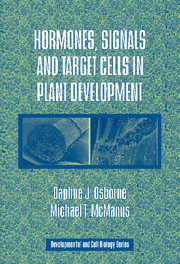Book contents
- Frontmatter
- Contents
- Preface
- 1 Introduction
- 2 Hormones and Signals: Identification and Description of Signalling Molecules
- 3 Cell-to-Cell Signalling: Short and Long Distance
- 4 Population Diversity of Cell Types and Target Identification in Higher Plants
- 5 Flexibility of Cell Types and the Target Cell Status
- 6 Terminally Committed Cell Types and the Target Status
- 7 The Mechanisms of Target Cell Perception and Response to Specific Signals
- 8 Hormone Action and the Relief of Repression
- 9 The Phenomenon of Hormonal Cross-Talk
- References
- Index
7 - The Mechanisms of Target Cell Perception and Response to Specific Signals
Published online by Cambridge University Press: 06 August 2009
- Frontmatter
- Contents
- Preface
- 1 Introduction
- 2 Hormones and Signals: Identification and Description of Signalling Molecules
- 3 Cell-to-Cell Signalling: Short and Long Distance
- 4 Population Diversity of Cell Types and Target Identification in Higher Plants
- 5 Flexibility of Cell Types and the Target Cell Status
- 6 Terminally Committed Cell Types and the Target Status
- 7 The Mechanisms of Target Cell Perception and Response to Specific Signals
- 8 Hormone Action and the Relief of Repression
- 9 The Phenomenon of Hormonal Cross-Talk
- References
- Index
Summary
In previous chapters we outlined the target cell concept, identified the signals and hormones that a cell will encounter and discussed how types of cells can be identified as of particular target status whether during development or on reaching a terminal state of differentiation. Now, over the next chapters, we ask how cells actually recognise signals and question whether the target state dictates, or is dictated by, the mechanisms for signal recognition in vivo. The original description of a hormone, borrowed from the animal world, was a regulatory substance synthesised in one part of the organism and transported to another in which it is recognised and the effect of the hormone becomes manifest. Although the plant has sites of major synthesis of hormone signals and they are all known to be transported, all the evidence tells us that the majority of cells probably contain some level of each hormone and are constantly exposed to the hormones emanating from their neighbours. The plant, after all, is a coenocyte in which all living cells intercommunicate by plasmodesmata and by surface contacts at the cell wall. Of the many signals to which each cell is continuously exposed, why are certain of these perceived and responded to? Or, does a cell respond to all signals that are above a threshold level? If so, how is the threshold level determined and is it fixed or variable?
Animal physiologists deduced the existence of, sought and found receptor proteins on cell surfaces and within the nucleus.
- Type
- Chapter
- Information
- Hormones, Signals and Target Cells in Plant Development , pp. 146 - 178Publisher: Cambridge University PressPrint publication year: 2005



